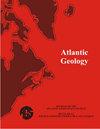加拿大、纽芬兰和拉布拉多地质协会章节摘要:2020年技术会议
IF 0.9
4区 地球科学
Q2 GEOLOGY
引用次数: 0
摘要
本研究的主要目的是确定Bay Bulls镇、Newfoundland镇和Labrador镇三个易受侵蚀的关键地区沿海道路的亚表面结构。关于地下的信息可以促进制定长期战略,减少沿海地区受气候变化影响的程度。三个可能引起海岸侵蚀的地点位于陡峭斜坡上的道路上。在海湾的北侧,在面包和奶酪遗址,道路面临着被海浪侵蚀的风险,而悬崖遗址的道路有一堵木制挡土墙,开始向侧面坍塌。在位于海湾公牛队南侧的码头,这条路非常靠近陡峭悬崖内的狭窄入口。为此,利用了三种地球物理技术——探地雷达(GPR)、直流电阻率(DCR)和实时运动学(RTK)分析,以及地质和海岸地貌观测。探地雷达探测通过发送雷达脉冲并记录反射来进行。该方法揭示了Bread and Cheese断裂区域的范围、Quays路的基岩和岩石结构界面,以及悬崖现场基岩和支撑梁的位置。DCR测量通过向地面发送电流来测量地面电阻率。DCR确定了地面的一般结构,即电阻率较高和较低的块体,然后将其与较强和较弱的基岩层相关联。总的来说,海湾公牛地区幸运地位于相对抵抗波浪作用的坚固基岩中。岩石断裂或道路位于第四纪覆盖层上的区域最容易退化。本文章由计算机程序翻译,如有差异,请以英文原文为准。
Geological Association of Canada, Newfoundland and Labrador Section Abstracts: Technical Meeting 2020
The primary aim of this study is to determine the sub-surface structure of coastal roads in three key areas prone to erosion in the town of Bay Bulls, Newfoundland and Labrador. Information about the subsurface can facilitate the development of long-term strategies to reduce coastal exposure to the effects of climate change. Three sites of potential concern for coastal erosion are on roads built on steep slopes. On the north side of the bay, at the Bread and Cheese site, the road faces the risk of being undercut by waves, whereas the Cliff site road has a wooden retaining wall which is starting to slump sideways. At the Quays, located on the south side of Bay Bulls, the road runs very close to narrow inlets within steep cliffs. Three geophysical techniques—ground-penetrating radar (GPR), direct current resistivity (DCR), and real-time kinematic (RTK) analysis — were utilized for this purpose, along with geological and coastal geomorphological observations. The GPR survey operates by sending a radar pulse down and recording reflections. The method revealed the extent of the fractured region at Bread and Cheese, the bedrock and rock structure interfaces on Quays road, and the location of bedrock and support beams at the Cliff site. DCR surveys measure the resistivity of the ground by sending an electric current into the ground. DCR identified the general structure of the ground, in terms of higher and lower resistivity blocks, which were then correlated with layers of stronger and weaker bedrock. In general, the Bay Bulls area is fortunate to be located in strong bedrock that is relatively resistant to wave action. Areas where the rock is fractured, or roads lie on Quaternary cover are most vulnerable to degradation.
求助全文
通过发布文献求助,成功后即可免费获取论文全文。
去求助
来源期刊

Atlantic Geology
GEOLOGY-
CiteScore
2.10
自引率
18.80%
发文量
0
审稿时长
>12 weeks
期刊介绍:
Atlantic Geology (originally Maritime Sediments, subsequently Maritime Sediments and Atlantic Geology) covers all aspects of the geology of the North Atlantic region. It publishes papers, notes, and discussions on original research and review papers, where appropriate to the regional geology.
 求助内容:
求助内容: 应助结果提醒方式:
应助结果提醒方式:


